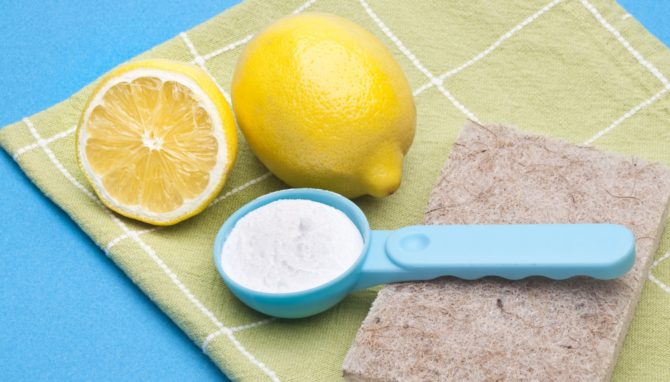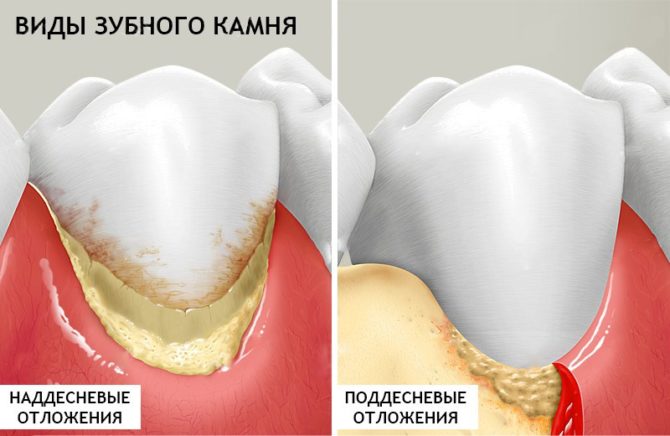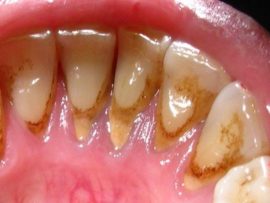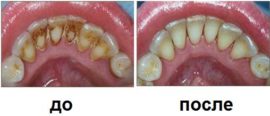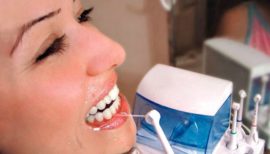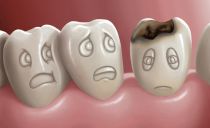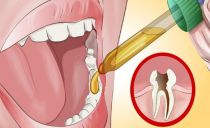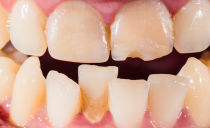How to clean teeth from stone: folk and professional methods
Every day, plaque accumulates on the teeth, consisting of food debris, epithelial cells, salts and bacteria. Usually it is easily cleaned during daily hygiene procedures. But if they are carried out irregularly or poorly, the soft film mineralizes and hardens.
Removal of tartar, which is these solid deposits, is carried out in the clinic using a mechanical, chemical or ultrasonic method. but You can prevent the development of the disease and reduce the scale of a cosmetic defect at home.
Content
Symptoms, types and complications
Tartar is a hardened plaque. Its formation lasts from three to six months. However, in the initial stages, the pathological process does not cause concern. The problem becomes apparent only at the moment when a person is faced with the physiological manifestations of the disease: itching, bad breath, redness and bleeding of the gums.
Outwardly, the initial stages of the development of the disease resemble the onset of caries. The only difference is that the stones do not appear on the chewing surface of the teeth. Forming a brown or yellow rim around the neck, they extend into the periodontal pocket, and sometimes on the crown.
By localization, tartar is divided into 2 types (see photo):
- Supragingival. It accumulates in the lower areas of enamel.
- Subgingival. Formed in pockets between teeth and gums.
The second type of deposits is more dangerous than the first, since the gum can become inflamed against its background, which is fraught with the development of gingivitis, periodontitis. It is impossible to diagnose subgingival tartar and get rid of it at home. This can be done only by a dental surgeon, since deposits are concentrated under the gum.
Both types of tartar are composed of salts, food debris, keratinized epithelial cells and pathogenic bacteria. The toxins that secrete microorganisms are absorbed into the bloodstream and spread throughout the body, affecting the organs of the gastrointestinal tract, respiratory tract and other internal systems. Therefore, tartar must be fought.
Causes of Tartar
In addition to non-compliance with hygiene, the following factors lead to the formation of hard deposits on the teeth:
-
Smoking. Nicotine is a sticky substance. It sticks to the enamel and remains on it in the form of a yellow coating. Over time, the film becomes mineralized and hardens.
- Abuse of fatty, sugary foods. If you do not remove the coating after sticky food, then its remnants will remain on the enamel. Such conditions contribute to the growth of bacteria that settle on the teeth in the form of deposits.
- The abuse of tea, coffee and other coloring drinks that leave a pigmented plaque on the tooth surface.
- Diseases of the internal organs.
Metabolic disorders, ulcers, gastritis, enterocolitis - these and other pathologies can cause solid plaque. They cause changes in the microflora of the oral cavity, which accelerate the formation of deposits and their mineralization. If you remove the tartar, after a while it will appear again.To get rid of the manifestation forever, it is necessary to treat the cause of its frequent occurrence.
- The inclusion in the diet of only soft foods: cereals, soups, fish and minced meat dishes. Chewing fresh vegetables, fruits helps to remove a solid part of the plaque. If you refuse to use solid products, the soft film is quickly converted to tartar.
- Chewing function impairment. Molars and incisors that do not participate in the process of grinding food are not cleaned naturally and are often covered with mineralized sediment.
- Antibiotic treatment and hereditary predisposition.
- The use of dubious hygiene products and devices. You need to choose high-quality toothbrushes and pastes, otherwise all hygiene measures will be in vain. Soft brushes are recommended only for people with increased sensitivity of the gums.
- Malocclusion. In places where the teeth are crowded, plaque accumulates faster.
How to get rid of tartar in a clinic
In dentistry, 4 methods are used to clean teeth from hard deposits, which differ in the principle of impact on plaque.
- Chemical. Active substances are used that can dissolve the mineralized precipitate. These are mainly acidic and alkaline mixtures. The procedure is carried out by an experienced dentist, since the preservation of the health of the gums and enamel depends on the selection of the concentration of the solutions.
-
Ultrasonic. A scaler is used - an ultrasonic device. Vibration waves form powerful turbulences on the tooth surface that crush hard deposits. This method of removing stones from teeth is the safest. The nozzle of the device does not come into contact with the tooth and therefore cannot harm it, unlike the same chemicals. But before using an effective dental method, you need to make sure that there are no contraindications: diabetes and cardiovascular diseases.
- Laser. The same principle is used as with the ultrasound method. However, the high cost of the equipment made the laser method of cleaning less common.
- Air Flow or Air Abrasive. This method of calculus removal involves enamel treatment with a solution of abrasive substances under pressure. As an independent method, it is rarely used. Typically, the bulk of the deposits is removed using a scaler, and the result is fixed using the air-abrasive method. Alone, it can be used in the early stages of stone formation, to eliminate pigmentation, polishing enamel, as the final stage of teeth whitening, and also to clean the mouth of hard-to-reach soft plaque.
- Mechanical. The sediment is dissolved by special means, after which they are cleaned with dental tools: spatulas, hooks, and nail files. This method of cleaning tartar is the most traumatic, therefore it is obsolete and is rarely used.
Tartar removal methods, video:
None of the methods are used in dentistry without first checking the condition of the gums and teeth. If necessary, anti-inflammatory therapy is carried out before cleaning, and in case of caries - filling.
How to remove tartar at home
You can get rid of soft plaque and the early stages of stone formation at home. For this, abrasive pastes, irrigators, hydrogen peroxide, salt, soda, decoctions of medicinal plants and other handy tools are used.
How to remove stones with special pastes
Hard plaque can be removed using an ordinary toothbrush and special pastes. Their composition includes such active substances:
- Grinding and abrasive components.
- Pyrophosphates, zinc compounds. They slow down the mineralization process and prevent the growth of bacteria.
- Bromelain and papain are plant enzymes that dissolve a solid precipitate, which simplifies the removal of plaque from enamel.
It is advisable to carry out toothbrushing with tartar pastes only with minor deposits. They are for prevention, not treatment. Massive pigment deposits accumulated over months or years cannot be cleaned with paste alone.
Owners of sensitive teeth are not at all recommended to remove a stone from them using such an aggressive method. Abrasive particles can provoke the formation of cracks on enamel and bleeding gums.
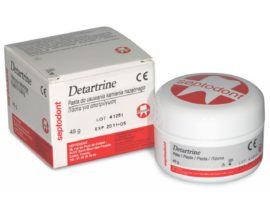 Those who decide to use toothpastes that remove the stone, dentists are advised to adhere to the following rules:
Those who decide to use toothpastes that remove the stone, dentists are advised to adhere to the following rules:
- Use them less than twice a week.
- Do not squeeze a large amount of the product onto the brush. To save enamel from deposits, one small pea is enough.
- Brushing your teeth for about three minutes, otherwise all actions will be in vain.
- Be sure to rinse your mouth after the procedure to prevent the ingestion of particles that will be harmful to health.
Getting rid of a stone with an irrigator
The principle of the device is to clean the interdental spaces with a pulsating stream of water. She penetrates the most inaccessible places and effectively removes stones from teeth, and also massages gums and improves blood circulation.
The device is often used when caring for crowns, prostheses, bracket systems. It can be used by children, as it is equipped with a water pressure adjustment mechanism.
For maximum effect, it is recommended to brush your teeth with an irrigator at least 2 times a day. But in order to prevent the occurrence of periodontal disease, it is worth starting with short-term sessions, gradually increasing the duration of the procedure to 3 minutes.
Irrigators should not be used for inflamed periodontal disease., since the impact on the gums with a powerful stream of water will aggravate the disease.
The fight against tartar using folk remedies
You can not buy expensive pastas and irrigators, because you can remove tartar at home and folk remedies. At the heart of any household method is a chemical process in which calcium salts dissolve in an acidic environment. After softening the stone deposits, the enamel is cleaned with a stiff brush.
Hydrogen peroxide
Peroxide can soften a stone well, as it contains active oxygen, which destroys the bond between deposits and enamel. Use this drug with extreme caution so as not to provoke gum sensitivity. To avoid pathological effects, it is necessary to dilute one part peroxide in three parts of water.
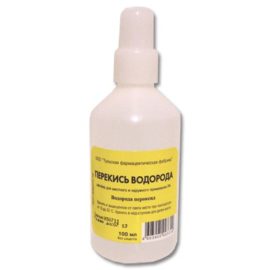 The solution is applied to problem areas with a tampon. After a few minutes, it is washed off with clean water, and then the softened coating is removed with a stiff brush using the traditional method. This method of calculus removal is used. no more than 1 time per week.
The solution is applied to problem areas with a tampon. After a few minutes, it is washed off with clean water, and then the softened coating is removed with a stiff brush using the traditional method. This method of calculus removal is used. no more than 1 time per week.
Other methods based on the use of hydrogen peroxide:
- Mask. Ingredients: 1 tsp. baking soda, 20 drops of a 3% preparation, 5 drops of lemon juice. The essence of the procedure: the mixture is applied to problem areas of enamel, kept for 2 minutes, and then rinsed thoroughly with mouth water at room temperature and brushed teeth without toothpaste.
- Polishing. Ingredients: 3 parts baking soda, 1 part peroxide. Technique of use: the product is applied to a cotton swab and rub enamel with it for 2 minutes, and then rinse the mouth with water and remove the plaque.
Horsetail
One tablespoon of grass is brewed in 250 ml of boiling water and used as a rinse aid. With the help of infusion, only soft plaque and stone are removed in the initial stages, therefore it is used as a prophylacticrather than therapeutic.
If you deal with plaque at least 3 times a day and keep the mixture in your mouth for more than three minutes, you will be able to prevent the formation of stone deposits, and at the same time many inflammatory diseases.
Honey broth
 A good result can be achieved if you rinse your mouth with honey broth. For its preparation, 1 tbsp. l honey should be dissolved in 200 ml of water. However, removing the stone quickly with this tool will not work. The effect will appear only after 2-3 months.
A good result can be achieved if you rinse your mouth with honey broth. For its preparation, 1 tbsp. l honey should be dissolved in 200 ml of water. However, removing the stone quickly with this tool will not work. The effect will appear only after 2-3 months.
The method is not suitable for people with hypersensitivity to the gums, since honey is a strong allergen.
Salt
You can remove tartar at home with ordinary salt. It is necessary to dip a moistened brush into it and just clean the enamel from plaque. Fine salt is preferred.because a large one can harm the gums.
Celandine root
 Rinsing with a celandine broth is the most dangerous way to remove tartar at home. But the most effective. To prepare the mixture, the root or leaves of celandine (15 g) are poured with boiling water (200 ml) and insisted for about half an hour. The resulting broth rinse your mouth 2 times a day. It is very important to exclude its ingestion, since celandine is an extremely toxic plant and a powerful allergen.
Rinsing with a celandine broth is the most dangerous way to remove tartar at home. But the most effective. To prepare the mixture, the root or leaves of celandine (15 g) are poured with boiling water (200 ml) and insisted for about half an hour. The resulting broth rinse your mouth 2 times a day. It is very important to exclude its ingestion, since celandine is an extremely toxic plant and a powerful allergen.
Lemon juice
Citrus juice contains a large amount of acid, which helps soften stone deposits. It helps to clean the stone and remove age spots. For the procedure, it is necessary to squeeze the juice on a cotton swab and apply on enamel. After 15 minutes, the product is washed off.
You can not brush your teeth from tartar with lemon juice more than 2 times a week. Organic acids soften not only plaque, but also enamel, which is fraught with leaching of calcium from it.
Soda
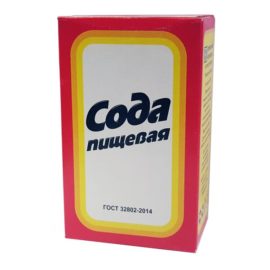 You can get rid of the stone by applying soda paste to the teeth. Prepare it from the following ingredients:
You can get rid of the stone by applying soda paste to the teeth. Prepare it from the following ingredients:
- 1 tsp soda;
- 3 drops of citric acid;
- 10 drops of hydrogen peroxide.
Applications should be done only in those places where there is solid deposits, so as not to harm healthy enamel. After using self-prepared pasta, it is recommended to repeat the procedure with remineralizing. It will protect the tooth surface from damage.
Preventive actions
The best way to remove tartar is prevention. You need to follow only 6 rules:
- Brush your teeth after eating, in the morning and before going to bed.
- Rinse your mouth with an antiseptic.
- Change brush once every 2 months.
- Do not smoke and limit alcohol consumption.
- Introduce solid foods into the diet: fresh fruits, vegetables.
- Visit the dental clinic at least once every six months.
And if tartar is still formed, remember that at home to remove it quickly and efficiently will not work. Only a dentist can do this. In addition, hard deposits can occur against the background of serious internal diseases that need to be treated. Therefore, postponing a visit to the doctor is stupid and dangerous.
Video: tartar removal at home

